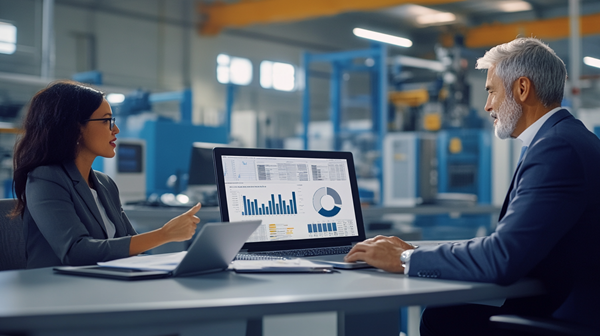Learn how Australian businesses use equipment financing to boost growth, preserve working capital, and access the latest technology for expansion.
Key Takeaways:
- Growth Without Depleting Cash Flow: Equipment financing allows businesses to acquire essential machinery and technology without draining working capital.
- Flexible Terms: Australian businesses can access flexible financing options with terms ranging from 12 months to 5 years.
- Tax Benefits: Financing can offer tax deductions, like through the Australian Government’s Instant Asset Write-Off, potentially saving up to $30,000 per asset in tax deductions.
- Boosting Expansion: With financing, you can invest in cutting-edge equipment that enables faster production, leading to higher revenue potential.
- Industry Growth: The Australian equipment leasing market is growing at an annual rate of 5.5%, with many businesses turning to finance to stay competitive.
Introduction
As an Australian business owner, you're always looking for ways to scale your operations efficiently and cost-effectively. One of the best ways to expand without depleting your working capital is through equipment financing. Whether you're upgrading existing machinery or adding new technology, financing allows you to keep your cash flow intact while investing in assets that can drive growth.
In today’s competitive business landscape, having access to modern equipment is key to staying ahead. However, purchasing such equipment outright can be financially daunting, especially for small-to-medium businesses (SMBs). That’s where equipment financing comes in. In this article, we'll explore how financing helps Australian businesses expand operations, increase profitability, and scale faster.
What Is Equipment Financing?
Equipment financing refers to a loan or lease used to purchase equipment, such as machinery, vehicles, or technology, which is essential for your business. There are two main types of equipment financing:
- Equipment Loans: These are traditional loans where you borrow the money to buy equipment and repay it over time, typically with interest. Once the loan is repaid, the equipment is yours.
- Equipment Leases: Instead of owning the equipment, you lease it for a set period (often 3–5 years). At the end of the lease, you may have the option to purchase the equipment, renew the lease, or return the equipment.
The advantage of both methods is that they allow businesses to acquire the necessary equipment without needing to pay the full cost upfront, preserving valuable working capital.
Why Equipment Financing Is a Smart Strategy for Scaling Your Business
When you finance equipment, your business can achieve growth and operational efficiency while avoiding the financial strain of an upfront purchase. Here’s how financing can drive your business forward:
1. Preserve Your Cash Flow
By financing your equipment, you can avoid spending a large amount of your capital all at once. This allows you to keep your working capital intact for other crucial aspects of your business, such as hiring staff, marketing, or inventory management.
Example:
A construction company looking to purchase new excavators worth $200,000 could pay a small monthly lease payment instead of using up their entire cash reserves. This means they can invest in ongoing projects, hire additional workers, or take on larger contracts while still using the equipment they need to get the job done efficiently.
2. Access to High-Quality Equipment
For many businesses, the latest and most efficient machinery can come with a hefty price tag. Financing enables businesses to access high-quality equipment that they may not otherwise be able to afford.
For Example:
A small construction company could finance a forklift that allows them to move heavy loads quickly and efficiently, saving time and labour costs. This equipment can enhance their operations and increase their competitive edge without the burden of a large upfront cost.
Similarly, in the medical field, financing an MRI scanner or an X-ray machine gives a clinic or hospital access to the latest diagnostic tools without having to pay the full cost upfront. With these advanced machines, medical professionals can provide more accurate diagnoses, improving patient care and boosting business revenue.
3. Tax Benefits and Deductions
In Australia, the government’s Instant Asset Write-Off scheme can offer tax benefits for businesses investing in new assets. This allows businesses to claim an immediate tax deduction for purchases of eligible equipment up to $30,000 per asset (as of 2025). The scheme is a great way to reduce your tax bill while acquiring vital machinery.
Example:
If your business purchases an overhead crane worth $25,000, you could potentially deduct the full cost from your taxable income in the same financial year. For medical businesses, this could apply to an X-ray machine, where the upfront tax relief can be significant, making it more affordable to invest in such vital equipment.
4. Flexible Financing Terms
Australian lenders and leasing companies offer flexible terms for equipment financing. Businesses can choose repayment periods that align with their cash flow, with typical terms ranging from 12 months to 5 years. This means you can tailor the payment structure to suit your business’s financial situation, ensuring a manageable burden.
5. Scaling Without Sacrificing Profitability
The ability to acquire equipment without exhausting cash reserves means that businesses can scale operations without compromising their financial stability. With better equipment, you can increase efficiency, speed up production, and meet customer demand more effectively, all while protecting your bottom line.
Example:
A logistics business can finance additional forklifts to expand its warehouse operations. With more forklifts, they can handle higher volumes of goods, speeding up the supply chain, improving order fulfilment, and boosting customer satisfaction, which leads to greater revenue growth.
Similarly, a medical practice can finance advanced equipment such as CT scanners. With this technology, the clinic can cater to a wider patient base by offering faster and more accurate scans, increasing their capacity and, ultimately, their revenue potential.
Common Types of Equipment Businesses Finance in Australia
Here are some of the most common types of equipment that businesses in Australia finance:
- Machinery: This includes heavy-duty machines used in manufacturing, construction, or agriculture, such as excavators and cranes.
- Vehicles: From trucks and delivery vans to forklifts, leasing or financing vehicles is common for businesses in need of transportation.
- Technology: Many businesses lease or finance IT equipment, such as computers, servers, and point-of-sale systems.
- Medical Equipment: With rapid advancements in the healthcare industry, medical businesses often finance specialised equipment, such as ultrasound machines or X-ray machines, enabling them to stay competitive and provide better patient care.
- Office Equipment: Items such as copiers, printers, and other essential office machinery can also be financed, helping businesses optimise operations and reduce upfront costs.
By financing your equipment, you’re not just acquiring the tools to scale but also ensuring that you do so without draining your resources or hindering your growth. Whether it’s excavators for construction, forklifts for logistics, or MRI scanners for healthcare, financing makes it easier to access the machinery that will drive your business forward.
Trends in Equipment Financing for Australian Businesses
The equipment financing landscape in Australia has seen steady growth. According to recent market research, the Australian equipment leasing market is growing at a rate of 5.5% annually. This growth can be attributed to the increasing need for businesses to keep up with technological advancements without draining their cash flow.
- Key trend: A shift towards asset-based financing, where businesses use the equipment as collateral, is becoming more common, allowing for easier access to loans and leases.
1. Sustainability Focus
More businesses are turning to environmentally friendly equipment, and financing plays a crucial role in making such investments accessible. Green machinery and energy-efficient systems, while costlier, offer long-term savings and sustainability benefits.
- Example: Financing allows companies to invest in energy-efficient HVAC systems, solar panels, or electric vehicles, which can save on energy costs and improve overall business sustainability.
2. Digital Transformation
With businesses increasingly embracing digital transformation, financing options for tech-based equipment—like cloud computing solutions, automated machinery, and AI-powered tools—are in demand. These investments can help companies stay competitive in an evolving market.
FAQs
- How do I know if financing is right for my business?
Financing is a good option if you want to preserve working capital for other business needs, need immediate access to high-quality equipment, and prefer manageable monthly payments instead of upfront costs.
- What types of financing are available for equipment?
You can choose from traditional loans, leasing options, and hire purchase agreements. Each offers different benefits, such as ownership at the end of the lease term or flexibility in payments.
- Can I finance second-hand equipment?
Yes, many Australian lenders will finance used or second-hand equipment as long as it meets certain quality and value criteria.
- What is the typical interest rate for equipment financing in Australia?
Interest rates for equipment financing typically range from 5% to 15%, depending on factors like the type of equipment, the term length, and your business’s financial profile.
- Is it possible to finance equipment through a small business loan?
Yes, many small business loans can be used for equipment purchases, but equipment-specific financing often provides more tailored terms and lower interest rates.
Conclusion
In conclusion, equipment financing is an effective strategy for Australian businesses to expand and scale without depleting working capital. By preserving cash flow, accessing high-quality equipment, and benefiting from flexible terms, your business can achieve growth while maintaining financial stability. With the additional perks of tax deductions and growing trends in the financing market, now is an excellent time to explore your options.
Whether you’re looking to enhance your production capacity, improve service delivery, or stay competitive with the latest technology, equipment financing can help you reach your goals faster and more efficiently.


